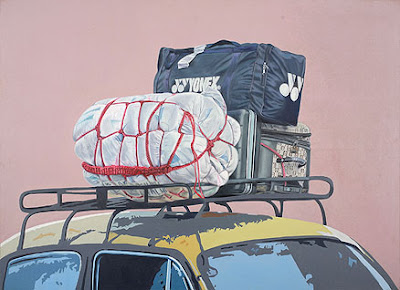
29 Aug 2008
28 Aug 2008
Printmaking
Recently, I came across a few artists who are taking photocopies of their paintings and selling them as prints. Buyer should not confuse these with traditional forms of limited edition fine art prints, which are produced with specialised techniques and have an investment value, as well. Fine art prints involve creating an image on a surface (called a matrix) and transferring it on to another surface, usually paper. Wood, metal or stone are commonly used as matrix in printmaking techniques. Print making usually involves a manual process to transfer the design onto the surface. Woodcut, lithography and etching are some of the methods used to produce a small number of multiples.
Offset printing on the other hand involves reproducing the original, and can produce a large number of copies.
In printmaking each print is numbered and signed by the artist, which also denotes the edition size (total number of multiples) and authenticity of the print. Traditionally, the block used to transfer the design was destroyed to prevent further copies from being produced.
Printmaking is an involved and labour intensive process and one finds that most trained printmakers are now moving away to different mediums which are either more rewarding in terms of creativity or financially.
Paintings by Mukesh Sharma

Talking about prints, I went for the preview of “Walled Expressions - Untold Tales”, an exhibition of paintings by the Jaipur based artist Mukesh Sharma. Essentially a printmaker, Mukesh’s recent oeuvre comprises of colourful imagery that weaves a narrative reminiscent of a painstakingly designed patchwork quilt. The intricately spun visuals borrow elements from Rajasthani art, miniatures, murals and folk arts amongst various other aspects.
Folk motifs from Rajasthani art, block prints from Sanganer, and rich colours from the desert come alive on the canvas. The geometric fragments along with swathes of brilliant colours and detailed motifs are juxtaposed seamlessly to form a kaleidoscope of imagery.
A fusion of people, practises, traditions and rituals his paintings capture the transformation that has occurred due to urbanization and present an amalgamated picture that is slowly evolving. A blend of ethnicity and contemporary, the paintings echo the dichotomy which is hard to ignore. Artists are invariably drawn to the socio-cultural effects of rapid development and progress, and interpret these in diverse forms. With a master’s degree in Fine Arts from MS University, Baroda, Mukesh works as a freelance artist.

The exhibition continues at Olive Beach till 22nd of September, Bangalore.
(Published in Bangalore Mirror)
27 Aug 2008
26 Aug 2008
List of Art Galleries, Bangalore
25 Aug 2008
Contemporary art market heading towards stabilization
A market report by the leading auction house Sothebys points out that the recent results from auctions of art suggests that the Contemporary art market appears to be stabilizing after several years of rapid growth. Although, the report takes into consideration all contemporary art, it is an important summarization that will have an impact on the growth of the Indian art market as well. The report suggests that the collector base appears to be broadening, which means that the market is likely to see a further stabilization in the future. It also discounts the idea that the art market prices are likely to fall due to the rapid rise seen in the last few years.
According to the ArtTactic Indian art market analysis, contemporary Indian art is gaining momentum, and more Indian works are likely to be seen in Western contemporary auction. In fact, the report suggests that this may even happen probably at the expense of Chinese contemporary art. Newer partnerships that are being forged between leading galleries and Indian artists will have far-reaching impact on the prices and will provide greater exposure to Indian artists. According to these reports the future of Indian art market looks secure, at the moment.

All eyes are now on the Saffronart autumn online auction of Contemporary Indian art, which will take place online from September 3 - 4. This auction features 130 works by 62 artists of modern and contemporary Indian art. Previews will be held in New York and Mumbai prior to the online auction. Next in line is Sothebys Modern and Contemporary Indian art auction, which will be held on Sep 18 in New York. The sale features 127 lots by senior and upcoming artists from the country. Jamini Roy, FN Souza, Ganesh Pyne, Atul Dodiya, Baiju Parthan, Jitish Kallat, Hema Upadhaya are some of the artists whose works will be auctioned at the sale. Collectors and investors will find it interesting to see the results from these two auctions as they will further indicate the growth rate of the Indian art market.

(Published in Financial Times. ET online - title for the story erroneously reads Contemporary art edging towards stagnation instead of stabilization)


